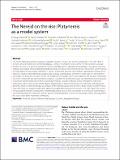The Nereid on the rise : Platynereis as a model system
Abstract
The Nereid Platynereis dumerilii (Audouin and Milne Edwards (Annales des Sciences Naturelles 1:195–269, 1833) is a marine annelid that belongs to the Nereididae, a family of errant polychaete worms. The Nereid shows a pelago‐ benthic life cycle: as a general characteristic for the superphylum of Lophotrochozoa/Spiralia, it has spirally cleaving embryos developing into swimming trochophore larvae. The larvae then metamorphose into benthic worms living in self‐spun tubes on macroalgae. Platynereis is used as a model for genetics, regeneration, reproduction biology, devel‐ opment, evolution, chronobiology, neurobiology, ecology, ecotoxicology, and most recently also for connectomics and single‐cell genomics. Research on the Nereid started with studies on eye development and spiralian embryogenesis in the nineteenth and early twentieth centuries. Transitioning into the molecular era, Platynereis research focused on posterior growth and regeneration, neuroendocrinology, circadian and lunar cycles, fertilization, and oocyte maturation. Other work covered segmentation, photoreceptors and other sensory cells, nephridia, and population dynamics. Most recently, the unique advantages of the Nereid young worm for whole‐body volume electron microscopy and single‐cell sequencing became apparent, enabling the tracing of all neurons in its rope‐ladder‐like central nervous system, and the construction of multimodal cellular atlases. Here, we provide an overview of current topics and methodologies for P. dumerilii, with the aim of stimulating further interest into our unique model and expanding the active and vibrant Platynereis community.
Citation
Özpolat , B D , Randel , N , Williams , E , Bezares-Calderon , L A , Andreatta , G , Balavoine , G , Bertucci , P , Ferrier , D E K , Gambi , M C , Gazave , E , Handberg-Thorsager , M , Hardege , J , Hird , C , Hsieh , Y-W , Hui , J , Nzumbi Mutemi , K , Schneider , S , Simakov , O , Vergara , H , Vervoort , M , Jékely , G , Tessmar-Raible , K , Raible , F & Arendt , D 2021 , ' The Nereid on the rise : Platynereis as a model system ' , EvoDevo , vol. 12 , 10 . https://doi.org/10.1186/s13227-021-00180-3
Publication
EvoDevo
Status
Peer reviewed
ISSN
2041-9139Type
Journal item
Description
Funding: EAW: BBSRC David Phillips Fellowship BB/T00990X/1. BDÖ: NIH NIGMS MIRA 1R35GM138008‑01; NSF‑EDGE Award no 1923429; Hibbitt Startup Funds. GJ, LABC, CH: Wellcome Trust Investigator Award 214337/Z/18/Z. KNM: Marie Sklodowska‑Curie fellow supported by the European Union’s Horizon 2020 research and innovation programme under grant agreement No. 766053, project EvoCELL. NR: European Union Horizon 2020, Marie Skłodowska‑Curie Grant No 838225. MCG: Stazione Zoologica A. Dohrn (Napoli) and the Ischia Marine Center technical staff; Open University PhD programme; ASSEMBLE; PON‑MODO project (Campania Region, Italy), RITMARE ‑ Flag project, Italy; MARES Consortium. Thanks to the ECCSEL ‑ NatLab Italy facilities, man‑ aged by the OGS (Trieste), to support collection at Panarea and Vulcano islands. JDH: NERC award NE/T001577/1. MHT: Deutsche Forschungsge‑ meinschaft (DFG), Grant Number TO563/7‑1. EG and MV: Labex ‘Who Am I?’ (No. ANR‑11‑LABX‑0071) funded by the French Government through its ‘Investments for the Future’ program operated by the ANR under Grant No. ANR‑11‑IDEX‑0005‑01, Centre National de la Recherche Scientifique (DBM Grant), Université de Paris (IDEX Emergence grant 2020), Agence Nationale de la Recherche (Grant TELOBLAST no. ANR‑16‑CE91‑0007; Grant STEM No. ANR‑19‑CE27‑0027‑02), the «Association pour la Recherche sur le Cancer» (Grant PJA 20191209482), and the «Ligue Nationale Contre le Cancer» (Grant RS20/75‑20). SQS: NSF (US) Award IOS‑1455185, MOST (TW ) 108‑2311‑B‑001‑002‑MY3, Academia Sinica Career Development Award AS‑CDA‑110‑L02, and the Institute of Cellular and Organismic Biology (ICOB) of Academia Sinica (TW ). YWH: Deutsche Forschungsgemeinschaft (DFG), grant number TO563/7‑1 (to Pavel Tomancak). OS: Austrian Science Fund Grant P32190. GB: The Balavoine Lab was funded by the CNRS, the Université de Paris and grants from the ANR (TELOBLAST no. ANR‑16‑CE91‑0007) and from the ARC (PJA 20181208248). FR and KTR: The research leading to these results has received funding from the European Research Council under the European Community’s Seventh Framework Programme (FP7/2007–2013)/ERC Grant Agreement 260304 (F.R.) and ERC Grant Agreement 337011 (K.T.‑R.); the Horizon 2020 Programme ERC Grant Agreement 81995 (K.T.‑R.); the research platforms ‘Rhythms of Life’ (K.T.‑R., F.R.) and “Single‑cell genomics of stem cells” (F.R.) of the University of Vienna; the Austrian Science Fund (FWF) START award, project Y413 (K.T.‑R.); the Austrian Science Fund (FWF) projects P28970 (K.T.‑R.) and I2972 (F.R.); the Austrian Science Fund (FWF) grant F78 (K.T.‑R., F.R.). DA and PB ERC Advanced grant NeuralCellTypeEvo #788921Collections
Items in the St Andrews Research Repository are protected by copyright, with all rights reserved, unless otherwise indicated.

